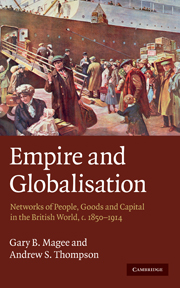Book contents
5 - Information and investment
Published online by Cambridge University Press: 05 June 2012
Summary
Introduction
So far we have examined the overseas movement of British people and British goods. This chapter concerns itself with Britain's other great export of the pre-First World War period: its capital. We seek to uncover the key relationships and mechanisms that made possible a massive and rapid movement of money across borders. For many scholars, it is this ‘runaway quality of global finance’ that lay at the very heart of the forces integrating the world economy in the nineteenth and twentieth centuries. Certainly, it had a profound and lasting effect, in its wake opening up new regions of the world, delivering efficiency gains from improved transport and communication, and widening the scope of the multi-lateral payments system. Britain's imperial and financial pre-eminence are, moreover, traditionally understood to have been two sides of the same coin.
Yet appearances can be deceptive. While the empire was at times prized by British investors, these same investors also freely sank even larger sums of money outside it. ‘Imperial piety’ or ‘British traditions’, of themselves, could not and did not replace the profit motive. Rather, it was the attractions of the rapidly expanding temperate regions of recent settlement – political stability, economic security and protection within the law – that mattered. These attractions were not confined to the British World, even if they manifested themselves most strongly there.
- Type
- Chapter
- Information
- Empire and GlobalisationNetworks of People, Goods and Capital in the British World, c.1850–1914, pp. 170 - 231Publisher: Cambridge University PressPrint publication year: 2010



